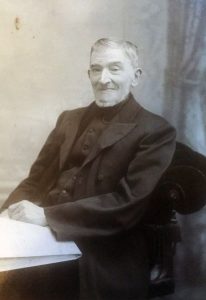
On November 3rd, 1856, Richard Robbins gave a lecture to the Launceston Mechanic’s and General Institute in which he recaptured his memories of the previous twenty to thirty years. Here is a small extract of that lecture;
‘There were the manganese mines of St. Stephens, paying wages to the amount of £500 per month, or £6,000 per year, and the Lifton, Stowford, Sydenham, and Dippertown mines paying monthly £1,400 or £16, 800 a year. We had the spinning jenny manufactures at New Mills, Town Mills, Ridgegrove, Wooda Road, and the island at St. Thomas bridge, these hives of industry employing hundreds of people, and paying wages at the rate of £250 per month or £3,000 per year, the greater part of which found its way into the tills of our shopkeepers, and adult females and girls and boys of eight years of age could then earn their own living. We had a thriving building trade, in which there were scores, if not hundreds, of hands as masons, carpenters, painters, and labourers. There was also a wholesale malting trade, carried on by Messrs. Perkyn, Greenaway, and Daniel Shilson, which necessarily engaged several persons. The hatting, tailoring, shoemaking, and smithy businesses were in a prosperous condition. There were the woollen, skin, and combing trades conducted by Messrs’ James Langdon, John Langdon, Walter Clease, Thomas Eyre, senior, Moses Symons, John Geake, William Hender, Edward Marshall, and last, though not least, William and Thomas Pearse, of Newport, which caused a large amount of money to be circulated in the town and district; and we can form some idea of the quantity of business in the three trades mentioned from the fact that there were three wool wash-houses on the higher side of the Town Mill leat, one below St. Thomas bridge, and another at St. Thomas Churchyard, in addition to several other extensive woollen and combing establishments at St. Thomas, Castle Dyke, and Fore Street (Northgate Street), as well as the serge factory at Town Mills. There was also a good trade with Bude and Boscastle, wagons plying to and from every day; and we had further a large flour business carried on by Mr. Bailey at Ridgegrove, Mr. Uglow at Town Mills, and Mr. Jury at Yeolmbridge, it being supposed that these three sent to Plymouth upwards of two hundred sack of flour weekly. To this long and healthy list must be added the garden and nursery business of Mr. Spry, which employed about fifteen hands, who received not less than £15 weekly in wages.
We were the centre of the great London Road, which created an immense traffic, the packets at that time coming and going through this place to London and Falmouth daily, and expresses continually riding from London to the west of Cornwall. Gentleman’s four-horse and other carriages were almost daily visiting the town, and, of course, benefiting some by their presence. There were two large wagon establishments on the London Road, those of Russell and Davis. The Spring Assizes were held here, which were the means of circulating hundreds, if not thousands, of pounds annually, and we had also the privilege, with Newport, of returning four members to Parliament, which caused a large amount of money to be spent, and in addition there were extensive gentlemen’s establishments kept up in the neighbourhood. The local taxation of the town was small compared with later years, and the shopkeepers and others had the power to erect stalls outside their houses, and in some instances they let them at from £3 to £10 annually; while another and a true indication of prosperity was seen in the fact that it was a very rare occurrence for houses to have the significant window sign ‘To be Let.’ Our markets also were extensive and largely supplied by the district around, so that the draper, the grocer, the druggist, and other tradesmen were busy from morning till night, customers being sometimes obliged, on account of the rush, to wait more than half-an-hour to be served. To give fresh impulse to trade the Tavistock, Western, and New North Roads were made, and, the prosperity of the town thus progressing, builders and others speculated in the erection of houses, and the necessary conveniences sprang up numerously and with great rapidity, causing the expenditure of many thousands of pounds in labour and materials.’
Richard then went on to described in detail the new buildings which had been erected at this thriving period, including the Central and the Western Subscription Rooms, the Tamar Terrace, the Independent Chapel, the Bible Christian Chapel, the Gas Works, the new King’s Arms, the National School, the Union Workhouse, and most of the best houses and shops now standing in the town; and he proceeded to say: ‘Matters went on prosperously in the various departments of industry. Labour was plentiful, rates and taxes moderate, provisions cheap (corn selling in 1835 and the following year at nine shillings per bag), contentment and plenty were residents of the cottage as well as of the mansion, and there was no complaining in our streets. The commercial affairs of the town continued to improve until 1837*, from which time it may be safely said our declension commenced.’
*The closing of the County Assizes in 1838 caused a terminal decline in the towns fortunes until the arrival of the railway in 1865.
Visits: 239
